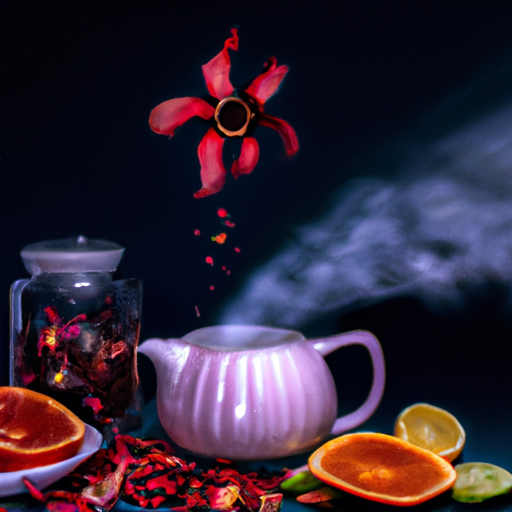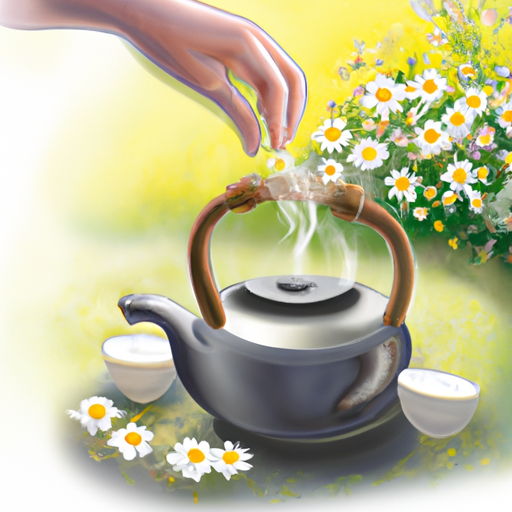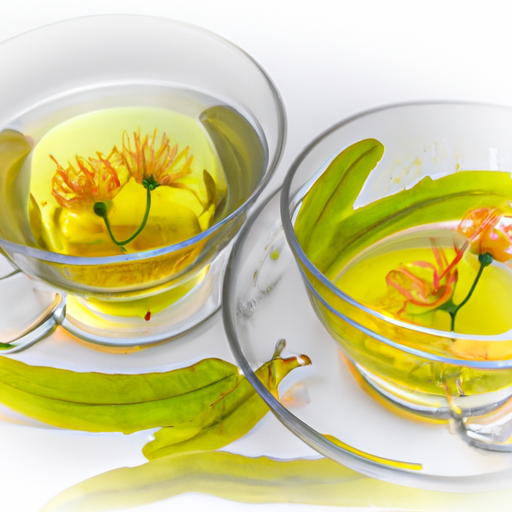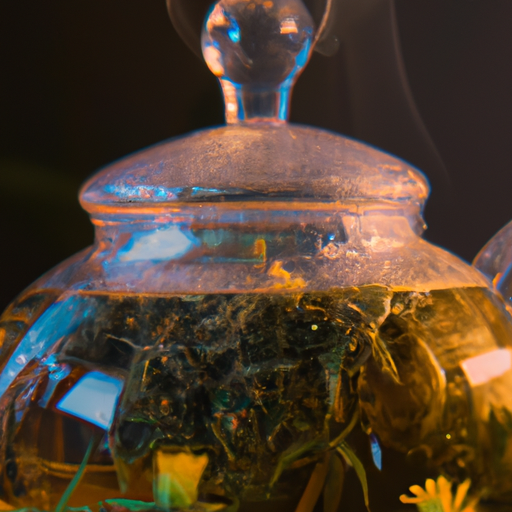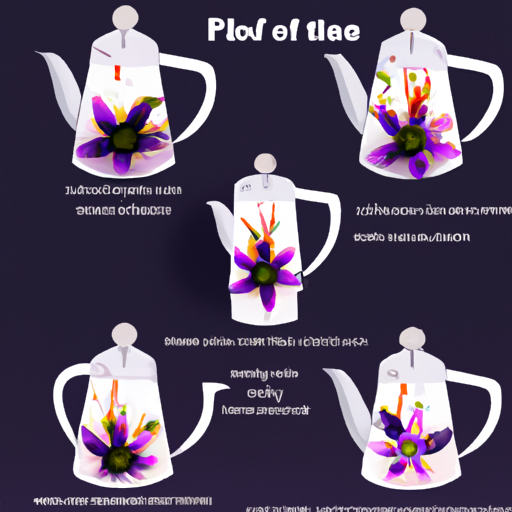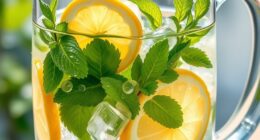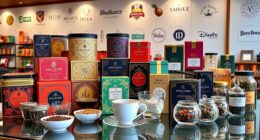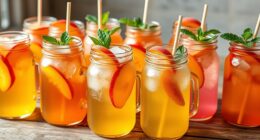As a tea enthusiast, I have always been intrigued by the various flowers that can be used to create aromatic and flavorful brews. One flower, in particular, has piqued my interest – the hibiscus flower. Renowned for its vibrant color and distinct tangy flavor, hibiscus tea not only tantalizes the taste buds but also offers a plethora of health benefits.
This theory has been extensively studied, and it is believed that hibiscus tea may aid in lowering blood pressure, improving digestion, and boosting immune function. Harnessing the power of hibiscus flowers for tea is not only a delightful experience but also a journey into the world of wellness and culinary creativity.
In this article, I will guide you through the process of selecting, drying, and brewing hibiscus flowers to create the perfect cup of tea. Additionally, I will explore the numerous ways you can incorporate hibiscus tea into your daily routine, both for its delicious taste and its potential medicinal uses.
Let’s embark on this floral adventure together and discover the wonders of hibiscus tea!
Key Takeaways
- Hibiscus tea offers health benefits such as lowering blood pressure, improving digestion, and boosting immune function.
- The strength of hibiscus tea depends on the steeping time of the flowers.
- High-quality, organic hibiscus flowers should be used for tea.
- Properly drying hibiscus flowers is important to prevent molding.
Understanding the Health Benefits of Hibiscus Tea
If you’re looking for a delicious and refreshing drink that also offers numerous health benefits, then hibiscus tea is the perfect choice for you. Not only does it have a vibrant and tangy flavor, but it also has several positive effects on your health.
One important factor to consider when preparing hibiscus tea is the brewing time. The longer you steep the hibiscus flowers, the stronger and more concentrated the tea will be. For a milder flavor, steep the flowers for around 5 minutes, while for a stronger brew, let them steep for 10 minutes or more.
One of the most significant health benefits of hibiscus tea is its impact on blood pressure. Several studies have shown that regularly consuming hibiscus tea can help lower both systolic and diastolic blood pressure. This is due to the presence of certain compounds in hibiscus flowers that have a vasodilatory effect, meaning they widen the blood vessels and allow for better blood flow. As a result, drinking hibiscus tea can contribute to a healthier cardiovascular system.
Moving on to choosing the right hibiscus flowers for tea, it is essential to select high-quality, organic flowers. These flowers should be vibrant in color and have a fresh scent. Avoid flowers that appear wilted or have a dull color, as these may not provide the best flavor and health benefits.
With this understanding of the health benefits and brewing techniques, let’s explore how to choose the perfect hibiscus flowers for your tea.
Choosing the Right Hibiscus Flowers for Tea
To ensure the most flavorful and vibrant brew, you’ll want to carefully select the perfect hibiscus petals for your soothing cup of herbal goodness. When choosing hibiscus flowers for tea, it’s important to prioritize organic options.
Organic flowers are grown without the use of harmful pesticides or chemicals, which can negatively impact the flavor and quality of your tea.
Another important consideration is whether to use dried or fresh hibiscus flowers. Dried flowers are a popular choice as they have a longer shelf life and are readily available. They’re also more concentrated in flavor, making for a stronger and more robust tea. On the other hand, fresh flowers provide a more delicate and subtle flavor profile, perfect for those who prefer a milder tea experience.
When using fresh hibiscus flowers, make sure they’re plucked at their peak ripeness. Look for vibrant, brightly colored petals that are free from blemishes or signs of wilting. Dried flowers should be dark red in color and have a slightly tangy aroma. Avoid flowers that appear dull or have a musty smell, as these may be old or of lower quality.
Choosing the right hibiscus flowers is just the first step in creating a delightful cup of hibiscus tea. Once you’ve selected your petals, it’s important to properly dry and store them for optimal flavor and freshness.
[Transition to subsequent section: ‘Properly drying and storing hibiscus flowers’]Properly Drying and Storing Hibiscus Flowers
Ensure that you carefully dry and store your selected hibiscus petals to preserve their vibrant flavor and freshness for your future brewing endeavors. The drying process is crucial as it removes moisture from the petals, preventing them from molding or losing their potency. There are a few drying techniques you can use to achieve the best results. The most common method is air drying, where you lay the petals in a single layer on a clean, dry surface and let them sit for about a week in a well-ventilated area away from direct sunlight. Another option is using a dehydrator, which speeds up the process by gently removing moisture at a low temperature. Whichever method you choose, make sure the petals are completely dry and brittle before moving on to storing them.
Proper storage methods are essential to maintain the quality of your dried hibiscus flowers. Airtight containers, such as glass jars or resealable bags, are ideal for preserving their freshness. It is important to keep them in a cool, dark place to protect them from heat and light, which can degrade the petals over time. Also, consider labeling the container with the date of drying to keep track of their freshness. When stored correctly, dried hibiscus flowers can retain their flavor and potency for up to a year.
Now that you have properly dried and stored your hibiscus petals, it’s time to move on to brewing the perfect cup of hibiscus tea.
Brewing the Perfect Cup of Hibiscus Tea
As the sun sets on a warm summer evening, the vibrant crimson petals release their essence, infusing the water with a burst of tangy sweetness, creating the perfect cup of hibiscus tea. Brewing the perfect cup of hibiscus tea requires careful attention to brewing techniques and tea pairing.
To begin, bring water to a boil and pour it over dried hibiscus flowers. Allow the tea to steep for 5-7 minutes, depending on your desired strength. The longer you steep, the stronger the tangy flavor becomes. Strain the tea to remove any remaining flower petals and pour into your favorite teacup.
Hibiscus tea is versatile and can be enjoyed as is or paired with other flavors. For a refreshing twist, add a squeeze of fresh lemon juice or a sprig of mint to enhance the tanginess. If you prefer a sweeter taste, a touch of honey or agave syrup can be added.
When it comes to tea pairing, hibiscus tea pairs well with light and fruity desserts, such as berry tarts or citrus sorbets. The tangy notes of the tea complement the sweetness of these treats, creating a harmonious combination.
Now that you’ve brewed the perfect cup of hibiscus tea, let’s explore the exciting world of flavor enhancements in the next section.
Adding Flavor Enhancements to Your Hibiscus Tea
Get ready to take your hibiscus tea to the next level by adding exciting flavor enhancements that’ll leave your taste buds craving for more.
Here are some flavor pairing suggestions and creative tea infusion techniques to enhance the taste and aroma of your hibiscus tea:
-
Citrus Twist: Add a squeeze of fresh lemon or lime juice to your hibiscus tea to give it a refreshing, tangy flavor. The citrusy notes complement the floral and tart flavors of hibiscus, creating a delightful combination.
-
Minty Freshness: Infuse your hibiscus tea with a few sprigs of fresh mint leaves. The cool, minty taste adds a refreshing and uplifting element to the tea, making it perfect for hot summer days.
-
Fruity Fusion: Experiment with different fruits to create unique flavor profiles. Try adding slices of fresh strawberries, oranges, or even a handful of berries to your hibiscus tea. The natural sweetness and fruity notes will enhance the overall taste and provide a burst of flavor.
By incorporating these flavor pairing suggestions and creative tea infusion techniques, you can elevate your hibiscus tea experience to new heights.
Now, let’s explore different variations of hibiscus tea and discover even more exciting ways to enjoy this delightful beverage.
Exploring Different Variations of Hibiscus Tea
In the previous subtopic, we discussed how to enhance the flavor of your hibiscus tea. Now, let’s delve into the exciting world of exploring different variations of hibiscus tea. By experimenting with various ingredients and recipes, you can create a wide range of flavors and experiences.
To help you get started, I have compiled a table below showcasing five unique hibiscus tea recipes. These recipes not only offer delightful taste combinations but also provide potential health benefits. For instance, hibiscus tea has been linked to weight loss due to its ability to suppress appetite and inhibit the production of fat cells.
| Recipe | Ingredients |
|---|---|
| Hibiscus Mojito | Hibiscus flowers, mint leaves, lime juice |
| Hibiscus Ginger Tea | Hibiscus flowers, ginger, honey |
| Hibiscus Iced Tea | Hibiscus flowers, orange slices, honey |
| Hibiscus Green Tea | Hibiscus flowers, green tea, lemon juice |
| Hibiscus Berry Punch | Hibiscus flowers, mixed berries, agave |
By incorporating these recipes into your daily routine, you can enjoy the refreshing flavors of hibiscus tea while potentially reaping its weight loss benefits. Now, let’s explore how to seamlessly incorporate hibiscus tea into your daily routine.
Incorporating Hibiscus Tea into Your Daily Routine
To seamlessly integrate hibiscus tea into your daily routine, consider incorporating it into your morning or afternoon rituals for a refreshing and health-boosting beverage. Here are four ways you can make hibiscus tea a regular part of your day:
-
Start Your Morning: Replace your usual cup of coffee or black tea with a steaming cup of hibiscus tea. Its natural tartness and vibrant color will wake up your senses and provide a gentle caffeine-free energy boost to kickstart your day.
-
Midday Pick-Me-Up: Instead of reaching for sugary sodas or energy drinks, opt for a chilled glass of hibiscus iced tea. Its natural sweetness and tanginess will quench your thirst and invigorate your body, keeping you hydrated and focused throughout the afternoon.
-
Pre-Workout Boost: Sip on hibiscus tea before hitting the gym or engaging in physical activities. Its high antioxidant content helps support cardiovascular health and may improve exercise performance by enhancing blood flow and reducing oxidative stress.
-
Evening Relaxation: Wind down in the evening by savoring a warm cup of hibiscus tea. Its calming properties can help relieve stress, promote better sleep, and aid in digestion after a meal.
By incorporating hibiscus tea into your daily routine, you can enjoy the numerous benefits of this vibrant flower throughout the day. Now, let’s explore the culinary uses of hibiscus flowers without missing a beat.
Exploring the Culinary Uses of Hibiscus Flowers
Discover the delectable ways you can incorporate the vibrant flavors and stunning colors of hibiscus flowers into your favorite dishes and desserts.
Hibiscus flowers aren’t just for tea; they can also be used in various culinary creations. The petals of the hibiscus flower can be used to infuse dishes with a unique tart and tangy flavor. They can be added to salads, stir-fries, and even used as a garnish for drinks.
The vibrant red color of the hibiscus flower petals can also add a visually appealing element to your dishes.
In addition to their culinary uses, hibiscus flowers also offer numerous health benefits. They’re rich in antioxidants, which can help protect the body against harmful free radicals. Hibiscus flowers are also known for their potential to lower blood pressure and cholesterol levels. Incorporating hibiscus flowers into your diet can be a delicious way to support your overall health and well-being.
As we delve into exploring the medicinal uses of hibiscus flowers, we’ll discover the many ways in which this beautiful flower can be used to promote health and wellness.
Exploring the Medicinal Uses of Hibiscus Flowers
After exploring the culinary uses of hibiscus flowers, it’s time to delve into their medicinal properties. I’m fascinated by the cultural significance hibiscus flowers hold in different parts of the world as I continue to discover the wonders of this vibrant flower.
From ancient Egypt to traditional Chinese medicine, hibiscus flowers have long been revered for their healing qualities.
One of the most popular ways to experience the medicinal benefits of hibiscus flowers is by brewing them into a tea. Hibiscus tea, known for its vibrant red hue and tangy flavor, is not only delicious but also packed with antioxidants and other compounds that may promote good health. However, it’s important to be aware of potential side effects, such as low blood pressure, drug interactions, and allergic reactions. It’s always a good idea to consult with a healthcare professional before incorporating hibiscus tea into your routine.
As I transition into the next section about tips for growing your own hibiscus flowers for tea, I’m eager to share the knowledge I’ve gained about this magnificent plant.
Tips for Growing Your Own Hibiscus Flowers for Tea
As you embark on your hibiscus-growing journey, the secrets to cultivating your very own vibrant and flavorful potion lie within these practical tips. To ensure a successful garden, proper garden maintenance is crucial. Hibiscus plants thrive in full sun, so find a sunny spot in your garden and ensure regular watering to keep the soil moist but not waterlogged. Additionally, hibiscus plants prefer well-drained soil, so make sure to amend the soil with organic matter to improve drainage.
When it comes to harvesting hibiscus flowers for tea, timing is key. The best time to harvest is in the morning when the flowers are fully open. Gently pluck the flowers from the plant, being careful not to damage the surrounding buds or leaves. It’s important to note that hibiscus flowers have a short shelf life, so it’s best to use them fresh.
To help you visualize the process, here is a table summarizing the key tips for growing and harvesting hibiscus flowers for tea:
| Tip | Description |
|---|---|
| Full Sun | Hibiscus plants thrive in full sun, so choose a sunny spot in your garden. |
| Regular Watering | Keep the soil moist by watering regularly, but avoid overwatering to prevent waterlogging. |
| Well-Drained Soil | Amend the soil with organic matter to improve drainage and create a suitable environment for hibiscus plants. |
| Morning Harvest | Harvest hibiscus flowers in the morning when they are fully open for the best flavor and aroma. |
By following these tips, you’ll be well on your way to growing your own hibiscus flowers for tea. Enjoy the process and savor the delightful flavors of your homemade hibiscus tea!
Frequently Asked Questions
Can hibiscus tea help with weight loss?
Yes, hibiscus tea can help with weight loss. It’s low in calories and acts as a natural diuretic, helping to reduce water weight. Additionally, hibiscus tea may help regulate blood sugar levels, which can aid in weight management.
To enjoy the benefits of hibiscus tea, try incorporating it into your daily routine. Follow hibiscus tea recipes such as hot or iced tea, or even add it to smoothies for a refreshing twist.
Is it safe to drink hibiscus tea during pregnancy?
Drinking hibiscus tea during pregnancy may not be the best idea. It’s like stepping on a slippery slope. While it’s a delightful beverage, it’s important to consider its potential side effects on fertility and the safety of drinking it while breastfeeding.
Research suggests that hibiscus tea may affect hormone levels and could potentially interfere with conception. It’s always best to consult with a healthcare professional before consuming any herbal teas during pregnancy or while breastfeeding.
Can hibiscus tea lower blood pressure?
Yes, hibiscus tea has been studied for its potential to lower blood pressure. Several studies have suggested that hibiscus tea may have antihypertensive effects due to its high content of antioxidants and polyphenols. However, it’s important to note that the results aren’t conclusive and more research is needed.
Additionally, hibiscus tea may have potential side effects such as dizziness and stomach discomfort, so it’s always advisable to consult with a healthcare professional before incorporating it into your diet.
How long does it take for hibiscus flowers to dry properly?
To achieve optimal results, it’s important to give hibiscus flowers ample time to dry. The drying process typically takes around 3-5 days, depending on various factors such as humidity levels and room temperature.
However, it’s crucial to note that the benefits of hibiscus tea extend beyond just its drying time. This vibrant flower is rich in antioxidants, which can promote healthier skin and a youthful complexion.
So, don’t rush the drying process and savor the wonderful benefits it brings.
Can hibiscus tea cure a sore throat?
Hibiscus tea has several benefits, including its potential to soothe a sore throat. The high vitamin C content in hibiscus tea can help boost the immune system and alleviate inflammation. To make hibiscus tea, steep dried hibiscus flowers in hot water for 5-10 minutes. You can also add other ingredients like ginger or honey for added flavor. Stay hydrated and try incorporating hibiscus tea into your daily routine to potentially ease a sore throat.
Conclusion
As I close my eyes and take a sip of the vibrant red hibiscus tea, a sense of rejuvenation washes over me. The delicate petals of the hibiscus flower have transformed into a healing elixir, offering countless health benefits.
From its ability to lower blood pressure to its rich antioxidants, this floral infusion is truly a gift from nature. Whether enjoyed hot or cold, hibiscus tea has become a staple in my daily routine, reminding me to take a moment for self-care and nourishment.
So, join me in unlocking the power of hibiscus flowers and let its beauty and healing properties uplift your spirit.

